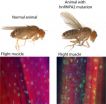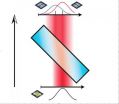(Press-News.org) PHILADELPHIA – A multi-institution group of researchers has found new candidate disease proteins for neurodegenerative disorders. James Shorter, Ph.D., assistant professor of Biochemistry and Biophysics at the Perelman School of Medicine, University of Pennsylvania, Paul Taylor, M.D., PhD, St. Jude Children's Research Hospital, and colleagues describe in an advanced online publication of Nature that mutations in prion-like segments of two RNA-binding proteins are associated with a rare inherited degeneration disorder affecting muscle, brain, motor neurons and bone (called multisystem proteinopathy) and one case of the familial form of amyotrophic lateral sclerosis (ALS).
"This study uses a variety of scientific approaches to provide powerful evidence that unregulated polymerization of proteins involved in RNA metabolism may contribute to ALS and related diseases," said Amelie Gubitz, Ph.D., a program director at the National Institute of Neurological Disorders and Stroke (NINDS).
ALS, or Lou Gehrig's disease, is a universally fatal neurodegenerative disease. Previous studies found that mutations in two related RNA-binding proteins, TDP-43 and FUS, cause some forms of ALS, but more proteins were suspected of causing other forms of the disease. TDP-43 and FUS regulate how the genetic code is translated for the assembly of proteins.
There are over 200 human RNA-binding proteins, including FUS and TDP-43, raising the possibility that additional RNA-binding proteins might contribute to ALS pathology. Computer algorithms, based on protein sequences, designed to identify yeast prions predict that around 250 human proteins, including several RNA-binding proteins associated with neurodegenerative disease, harbor a distinctive prion-like segment. These segments are essential for the assembly of certain protein complexes. But, the interplay between human prion-like segments and disease is not well understood.
Using yeast as a model organism, co-author Aaron Gitler, while at Penn in 2011, surveyed 133 of 200-plus candidate human RNA-binding proteins to predict new ALS disease genes, other than TDP-43 and FUS. They further winnowed the candidates to about 10 proteins with prion-like segments, and selected two candidates, TAF15 and EWSR1, for further study. Both TAF15 and EWSR1 aggregated in the test tube and were toxic in yeast.
Remarkably, they also uncovered TAF15 and EWSR1 mutations in ALS patients that were not found in healthy individuals. Based on these findings, they proposed that RNA-binding proteins with prion-like segments might contribute very broadly to the pathology of ALS and related brain disorders.
Characterizing the Top-Ten
Taylor, Gitler, Shorter, and others continued to characterize the top-ten human RNA-binding proteins with prion-like segments. The Nature study describes that two more of the top-ten candidates, called hnRNPA1 and hnRNPA2B1, are mutated and cause familial cases of brain disease. The mutations in hnRNPA1 and hnRNPA2B1 were present in two families with an extremely rare inherited degeneration affecting muscle, brain, motor neuron, and bone and another from a person with familial ALS.
Mutations in these two proteins fell in the prion-like segments and coincided with "sticky" regions in the proteins, making these regions more prone to assemble into self-organizing fibrils. The normal form of the proteins shows a natural tendency to assemble into fibrils, which is exacerbated by the disease mutations.
"The mutations accelerate the formation of the fibrils that recruit normal protein to form more fibrils," noted co-first author Emily Scarborough, from Penn. This dysregulated assembly likely contributes to disease. Indeed, the disease mutations also promote excess incorporation of the proteins into stress granules within a cell and the formation of clumps in the cells of animal models of human neurodegenerative disease.
"Neurodegenerative disease could ensue from unregulated fibril formation initiated spontaneously by environmental stress or another factor that regulates a protein's assembly," says Scarborough.
"This paper reflects an amazing collaborative effort and provides a great example of how understanding the underlying pure protein biochemistry can help explain how genetic mutations might cause pathology and disease," says Shorter.
"The findings confirm a strong prediction that the disease-causing mutations make the prion-like segment 'stickier' and more prone to clump," added co-first author Zamia Diaz, also from Penn.
Diseases associated with fibrils forming from prion-like domains in proteins frequently show "spreading" pathology, in which cellular degeneration via inclusions starts in one center of the brain and "spreads" to neighboring tissue. Although not directly addressed in the Nature study, the findings suggest that cell-to-cell transmission of a self-templating protein could contribute to the spreading pathology that is characteristic of these diseases.
"Related proteins with prion-like domains must be considered candidates for initiating and perhaps propagating similar pathologies in muscle, brain, motor neurons, and bone," concluded Shorter.
INFORMATION:
The research was funded in part by the by Ellison Medical Foundation, an NIH Innovator Fund award, NINDS (DP2OD002177, NS067354), and The Packard Center for ALS Research at Johns Hopkins.
Penn Medicine is one of the world's leading academic medical centers, dedicated to the related missions of medical education, biomedical research, and excellence in patient care. Penn Medicine consists of the Raymond and Ruth Perelman School of Medicine at the University of Pennsylvania (founded in 1765 as the nation's first medical school) and the University of Pennsylvania Health System, which together form a $4.3 billion enterprise.
The Perelman School of Medicine is currently ranked #2 in U.S. News & World Report's survey of research-oriented medical schools. The School is consistently among the nation's top recipients of funding from the National Institutes of Health, with $479.3 million awarded in the 2011 fiscal year.
The University of Pennsylvania Health System's patient care facilities include: The Hospital of the University of Pennsylvania -- recognized as one of the nation's top "Honor Roll" hospitals by U.S. News & World Report; Penn Presbyterian Medical Center; and Pennsylvania Hospital — the nation's first hospital, founded in 1751. Penn Medicine also includes additional patient care facilities and services throughout the Philadelphia region.
Penn Medicine is committed to improving lives and health through a variety of community-based programs and activities. In fiscal year 2011, Penn Medicine provided $854 million to benefit our community.
Adding to the list of disease-causing proteins in brain disorders
Proteins with mutations in 'prion-like' segments considered candidates for inherited forms of ALS, multisystem proteinopathy
2013-03-04
ELSE PRESS RELEASES FROM THIS DATE:
Getting around the Uncertainty Principle
2013-03-04
Researchers at the University of Rochester and the University of Ottawa have applied a recently developed technique to directly measure for the first time the polarization states of light. Their work both overcomes some important challenges of Heisenberg's famous Uncertainty Principle and also is applicable to qubits, the building blocks of quantum information theory.
They report their results in a paper published this week in Nature Photonics.
The direct measurement technique was first developed in 2011 by scientists at the National Research Council, Canada, to measure ...
Cancer vaccines self-sabotage, channel immune attack to injection site
2013-03-04
HOUSTON – Cancer vaccines that attempt to stimulate an immune system assault fail because the killer T cells aimed at tumors instead find the vaccination site a more inviting target, scientists at The University of Texas MD Anderson Cancer Center report in Nature Medicine.
A common substance used in many cancer vaccines to boost immune attack betrays the cause by facilitating a buildup of T cells at the vaccination site, which then summon more T cells to help with the perceived threat.
"Vaccines stimulate production of T cells primed to attack the target cancer, and ...
2 new genes linked to amyotrophic lateral sclerosis and related disorders
2013-03-04
A study led by St. Jude Children's Research Hospital has discovered mutations in two genes that lead to the death of nerve cells in amyotrophic lateral sclerosis (ALS), also known as Lou Gehrig's disease, and related degenerative diseases.
The same mutation occurred in both genes and led to the abnormal build-up of the proteins inside cells. These proteins play an essential role in normal RNA functioning and have also been linked to cancer, including the Ewing sarcoma, the second most common type of bone cancer in children and adolescents. The finding is the latest in ...
Study maps human metabolism in health and disease
2013-03-04
Scientists have produced an instruction manual for the human genome that provides a framework to better understand the relationship between an individual's genetic make-up and their lifestyle.
The international team of researchers say their study – published in Nature Biotechnology – provides the best model yet to explain why individuals react differently to environmental factors such as diet or medication.
"This research is the second important stage of our understanding of the human genome," said study author Professor Pedro Mendes, from The University of Manchester's ...
Researchers describe first 'functional HIV cure' in an infant
2013-03-04
A team of researchers from Johns Hopkins Children's Center, the University of Mississippi Medical Center and the University of Massachusetts Medical School describe the first case of a so-called "functional cure" in an HIV-infected infant. The finding, the investigators say, may help pave the way to eliminating HIV infection in children.
A report on the case is scheduled for presentation at a press conference on Sunday, March 3, at the 20th Conference on Retroviruses and Opportunistic Infections (CROI) in Atlanta. Johns Hopkins Children's Center virologist Deborah Persaud, ...
International consortium builds 'Google Map' of human metabolism
2013-03-04
Building on earlier pioneering work by researchers at the University of California, San Diego, an international consortium of university researchers has produced the most comprehensive virtual reconstruction of human metabolism to date. Scientists could use the model, known as Recon 2, to identify causes of and new treatments for diseases like cancer, diabetes and even psychiatric and neurodegenerative disorders. Each person's metabolism, which represents the conversion of food sources into energy and the assembly of molecules, is determined by genetics, environment and ...
Man-made material pushes the bounds of superconductivity
2013-03-04
MADISON — A multi-university team of researchers has artificially engineered a unique multilayer material that could lead to breakthroughs in both superconductivity research and in real-world applications.
The researchers can tailor the material, which seamlessly alternates between metal and oxide layers, to achieve extraordinary superconducting properties — in particular, the ability to transport much more electrical current than non-engineered materials.
The team includes experts from the University of Wisconsin-Madison, Florida State University and the University ...
International consortium discovers seven new genomic regions associated with AMD
2013-03-04
(Boston) – An international group of researchers has discovered seven new regions of the human genome—called loci—that are associated with increased risk of age-related macular degeneration (AMD), a leading cause of blindness. The AMD Gene Consortium, a network of international investigators representing 18 research groups, also confirmed 12 loci identified in previous studies. The study, which is published online in Nature Genetics and represents the most comprehensive genome-wide analysis of genetic variations associated with AMD, was supported by the National Eye Institute ...
Genetic risk factors for common eye disorder come into focus
2013-03-04
An international group of investigators has identified seven new genetic regions associated with age-related macular degeneration (AMD), a common cause of blindness in older individuals. The findings, reported online March 3 in Nature Genetics, could point to new biological pathways and therapeutic targets for AMD.
The AMD Gene Consortium, a network of 18 research groups supported by the National Eye Institute, also confirmed 12 genetic loci identified in previous studies. The study represents the most comprehensive genome-wide analysis of genetic variations associated ...
ADHD takes a toll well into adulthood
2013-03-04
BOSTON, Mass, March 4, 2013—The first large, population-based study to follow children with attention-deficit hyperactivity disorder (ADHD) into adulthood shows that ADHD often doesn't "go away," and that children with ADHD are more likely to have other psychiatric disorders as adults. Although numbers were small, they also appear more likely to commit suicide and are often incarcerated as adults.
"Only 37.5 percent of the children we contacted as adults were free of these really worrisome outcomes," says William Barbaresi, MD, of Boston Children's Hospital, lead investigator ...
LAST 30 PRESS RELEASES:
Making lighter work of calculating fluid and heat flow
Normalizing blood sugar can halve heart attack risk
Lowering blood sugar cuts heart attack risk in people with prediabetes
Study links genetic variants to risk of blinding eye disease in premature infants
Non-opioid ‘pain sponge’ therapy halts cartilage degeneration and relieves chronic pain
AI can pick up cultural values by mimicking how kids learn
China’s ecological redlines offer fast track to 30 x 30 global conservation goal
Invisible indoor threats: emerging household contaminants and their growing risks to human health
Adding antibody treatment to chemo boosts outcomes for children with rare cancer
Germline pathogenic variants among women without a history of breast cancer
Tanning beds triple melanoma risk, potentially causing broad DNA damage
Unique bond identified as key to viral infection speed
Indoor tanning makes youthful skin much older on a genetic level
Mouse model sheds new light on the causes and potential solutions to human GI problems linked to muscular dystrophy
The Journal of Nuclear Medicine ahead-of-print tip sheet: December 12, 2025
Smarter tools for peering into the microscopic world
Applications open for funding to conduct research in the Kinsey Institute archives
Global measure underestimates the severity of food insecurity
Child survivors of critical illness are missing out on timely follow up care
Risk-based vs annual breast cancer screening / the WISDOM randomized clinical trial
University of Toronto launches Electric Vehicle Innovation Ontario to accelerate advanced EV technologies and build Canada’s innovation advantage
Early relapse predicts poor outcomes in aggressive blood cancer
American College of Lifestyle Medicine applauds two CMS models aligned with lifestyle medicine practice and reimbursement
Clinical trial finds cannabis use not a barrier to quitting nicotine vaping
Supplemental nutrition assistance program policies and food insecurity
Switching immune cells to “night mode” could limit damage after a heart attack, study suggests
URI-based Global RIghts Project report spotlights continued troubling trends in worldwide inhumane treatment
Neutrophils are less aggressive at night, explaining why nighttime heart attacks cause less damage than daytime events
Menopausal hormone therapy may not pose breast cancer risk for women with BRCA mutations
Mobile health tool may improve quality of life for adolescent and young adult breast cancer survivors
[Press-News.org] Adding to the list of disease-causing proteins in brain disordersProteins with mutations in 'prion-like' segments considered candidates for inherited forms of ALS, multisystem proteinopathy


